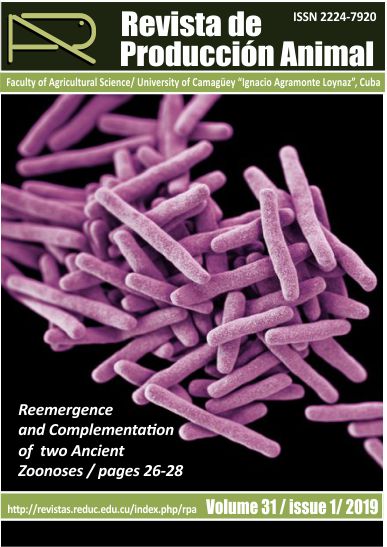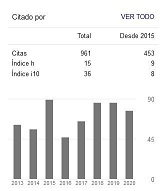Reproductive Traits in Culled Native Cows from Three Herds in Huambo Province, Angola
Resumen
A reproductive characterization of culled native cows was performed to three herds in Huambo province, Angola. The study made in June revealed that 54 of all the cows evaluated (331) in the three herds were culled animals (24, 17, and 3 per herd, respectively). Age, body condition (BC), total calving (TC), and calving interval (CI) were determined. General descriptive statistics was performed, and the factor studied was the herd. Age was distributed normally and the herds were compared through ANOVA, and Tukey for multiple comparison of means. The other variables (BC, TC, and CI) were evaluated through the Krustall Wallis method and U-Mann-Whitney statistics. The general age mean was 8.15±1.80, and the medians for BC, TC, and CI were, 2.5, 3.0, and 730.0, respectively. Overall, the results were distant from the optimal values of reproduction. The BC (P <0.05), TC, (P<0.01), and CI (P<0.01) were significantly influenced by the herd. Regardless of the herd effect, the poor utilization of the productive potential was caused by early culling, with insufficient excessively prolonged TC and CI periods, in addition to nutritional problems expressed in low BC.
Descargas
Citas
ADAMCZYK, K.; MAKULSKA, J.; JAGUSIAK, W. y WĘGLARZ, A. (2017). Associations Between Strain, Herd Size, Age at First Calving, Culling Reason and Lifetime Performance Characteristics in Holstein-Friesian cows. Animal, 11 (2), 327-334.
ADAMCZYK, K.; ZABORSKI, D.; GRZESIAK, W.; MAKULSKA, J. y JAGUSIAK, W. (2016). Recognition of Culling Rea-sons in Polish Dairy Cows using Data Mining Methods. Computers and Electronics in Agriculture, 127 (1), 26-37.
ÁLVAREZ, J. L.; MARTÍNEZ, G.; MONTES, I.; ORTA, S.; PLANAS, M. T.; PUENTES, T., et al. (2005). Cría vacuna. Tec-nologías para aumentar la eficiencia reproductiva (2da ed.). La Habana, Cuba: Sociedad Cubana de Criadores de Ganado de Carne y Doble Propósito (SOCCA).
ALVÅSEN, K.; DOHOO, I.; ROTH, A. y EMANUELSON, U. (2018). Farm characteristics and management routines re-lated to cow longevity: a survey among Swedish dairy farmers. Acta Vet Scand, 60 (38), 1-11.
ARMENGOL, R. y FRAILE, L. (2018). Descriptive Study for Culling and Mortality in Five High-Producing Spanish Dairy Cattle Farms (2006-2016). Acta Vet Scand, 60 (45), 1-11.
BERTOT, J. A.; DÍAZ, Y.; AVILÉS, R.; VÁZQUEZ, R.; ALVAREZ, J. L.; GARAY, M., et al. (2001). Factores que influyen en la duración de la vida reproductiva útil en rebaños bovinos de la provincia de Camagüey, Cuba. Rev. prod. anim., 13 (2), 77-80.
BOUJENANE, I. (2017). Reasons and Risk Factors for Culling of Holstein Dairy Cows in Morocco. Journal of Live-stock Science and Technologies, 5 (1), 25-31.
COMPTON, W. R.; HEUER, C.; THOMSEN, P. T.; CARPENTE, T. E.; PHYN, V. C. y MCDOUGALL, S. (2017). Invited Review: A Systematic Literature Review and Meta-Analysis of Mortality and Culling in Dairy Cattle. J. Dairy Sci., 100 (1), 1-16.
D’ANDRE, C.; RUGIRA, D.; MUREKEZI, T.; DAMASCENE, J.; KAYITESI, A.; MUSEMAKWERI, A., et al. (2017). Man-agement and Phenotypic Features of Indigenous Cattle in Rwanda. International Journal of Livestock Produc-tion, 8 (7), 95-112.
DE SOUZA, A.; CAMISÃO, J.; DE ANDRADE, I. F.; FONSECA, R. T. y CIRILLO, M. Â. (2008). Characterization of Cat-tle Slaughtered at the Public Abattoir in Lavras-MG. Ciênc. agrotec., 32 (1), 251-257.
EDMONSON, A. J.; LEAN, I. J.; WEAVER, L. D.; FARVER, T. y WEBSTER, G. (1989). A Body Condition Scoring Chart for Holstein Dairy Cows. J. Dairy Sci., 72 (1), 68-78.
GALLO, L.; STURARO, E. y BITTANTE, G. (2017). Body Traits, Carcass Characteristics and Price of Cull Cows as Af-fected by Farm Type, Breed, Age and Calving to Culling Interval. Animal, 11 (4), 696-704.
HOLÝ, L. (1987). Biología de la reproducción bovina. La Habana, Cuba: Editorial Científico Técnica.
LUENGO, L. J.; AROS, I. C. y GÓMEZ, R. L. (1990). Determinación de la edad del bovino según las características morfológicas de los dientes incisivos. Contribución a la aplicación de la norma chilena 1423 Of. 84. Terminolo-gía y clasificación. Avances de Medicina Veterinaria, 5 (1), 14-20.
MCCABE, S.; PRENDIVILLE, R.; EVANS, R.; O’CONNELL, N. E. y MCHUGH, N. (2018). Effect of Cow Replacement Strategy on Cow and Calf Performance in the Beef Herd. Animal, 2 (1), 1-9.
MOHD, N.; STEENEVELD, W.; MOURITS, C. M. y HOGEVEEN, H. (2015). The Optimal Number of Heifer Calves to be Reared as Dairy Replacements. J. Dairy Sci., 98 (1), 1-11.
NFOR, B. M.; CORAZZIN, M.; FONTEH, F. A.; AZIWO, N. T.; GALEOTTI, M. y PIASENTIER, E. (2014). Quality and Safety of Beef Produced in Central African. Italian Journal of Animal Science, 13 (3), 392-397.
NYAMUSHAMBA, G. B.; MAPIYE, C.; TADA, O.; HALIMANI, T. E. y MUCHENJE, V. (2017). Conservation of Indige-nous Cattle Genetic Resources in Southern Africa’s Smallholder Areas: Turning Threats Into Opportunities. A re-view. Asian-Australas J. Anim Sci., 30 (5), 603-621.
PANDEY, S.; SINGH, C. V. y BARWAL, R. S. (2016). Selective Value, Quantification and Genetic Parameters of Com-ponents of Replacement Traits in Crossbred Cattle. Vet. Med. Open J., 1 (1), 1-5.
ROBERTS, A. J.; PETERSEN, K. y FUNSTON, R. N. (2015). Can We Build the Cow Herd by Increasing Longevity of Females? J. Anim. Sci., 93 (1), 4235-4243.
SHITTU, A.; ZAHARADEEN, M. M.; FASINA, F. O.; UMARU, M. A. y AHMED, A. (2014). Classification of Slaughtered Animals and Estimation of Body Condition Scores During Rainy Season in Sokoto Abattoir. Sokoto Journal of Veterinary Sciences, 12 (2), 31-40.
SPSS (2006). SPSS 15.0 para Windows (Versión 15.0.1).
TATAR, A. M.; DENIZ, H. y TUTKUN, M. (2017). Reasons for Culling and Replacement Rate in Dairy Cattle. Animal Science, 60 (1), 49-51.
Los autores de los artículos publicados en RPA retienen los derechos de autor de su trabajo, de marca y patente, y también sobre cualquier proceso o procedimiento descrito en el artículo, así como a compartir, copiar, distribuir, ejecutar y comunicar públicamente el artículo publicado en la RPA o cualquier parte de aquel siempre que indiquen la fuente de publicación (autores del trabajo, revista, volumen, número y fecha), pero están de acuerdo en que la revista publique los trabajos bajo una licencia Creative Commons.
![]() Licencia Attribution-NonCommercial 4.0 International (CC BY-NC 4.0)
Licencia Attribution-NonCommercial 4.0 International (CC BY-NC 4.0)






































